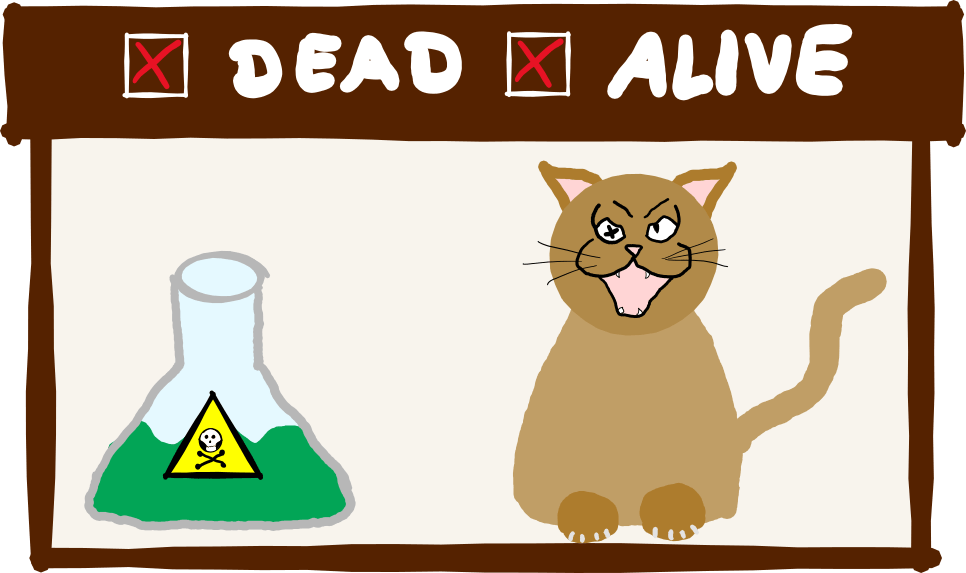Polar ice, the moon, the quantum world – what do these places have in common? There is no Wi-Fi? Possibly. It’s uncomfortable? Probably. They are uninhabited? Not at all! All these places have (allegedly) already been seen by a certain living being. Sometimes by choice, sometimes by design, sometimes by accident. What kind of creature is it that hangs around in such exotic, hostile places? It is small, chubby and it’s name: Tardigrade! In 2014, tardigrades were found in the Arctic that had been “hibernating” for over 30 years. Since a crash landing of an Israeli space probe in 2019, a few tardigrades have been lying on the moon. And according to a group of researchers, tardigrades have now also made the leap into the quantum world! But is that really true?
It all started just before Christmas, when an international team of researchers claimed that they had entangled a tardigrade with a qubit. The preprint (i.e. a pre-published and freely accessible article that has not yet been checked for accuracy by peers) bears the seemingly unambiguous title “Entanglement between superconducting qubits and a tardigrade“. Entanglement, that sounds like Schrödinger’s cat (see info box). Is the tardigrade the first undead living being? The first animal that knows how Schrödinger’s cat feels?
Schrödinger’s Cat
Schrödinger presented his famous thought experiment in 1935 to express his doubts about the interpretation of quantum physics. He imagined the following: Put a cat in a box together with a vial of poison and a radioactive atom. As soon as the atom decays, it triggers a mechanism that smashes the bottle, releases the poison and kills the cat (yes, Schrödinger was apparently no cat lover).
But the radioactive decay of the atom is a quantum mechanical process. This means that I cannot predict with any means in the world exactly when the atom will decay. I can only predict the probability with which it will decay within a certain period of time.
Let’s assume that I have waited long enough for the probability of decay to be 50%. The special thing about quantum systems is: as long as I do not measure the decay, i.e. I leave the atom alone, it is in a superposition of the two options “decay” and “not decay”, each with a weight of 50%. We call this superposition. To put it casually, this means: the atom is “decaying” and “not decaying” at the same time.
But what does this mean for the cat? The health of the cat depends directly on the state of the atom – we say: the cat and the atom are entangled. If we know what the atom is doing, we also know how the cat is doing. If the atom is “decayed” and “not decayed” at the same time, is the cat dead and alive at the same time?
Absurd, Schrödinger said. No one has ever seen a half-dead-half-alive cat. Something can’t be right when a theory predicts zombie cats. And Schrödinger did indeed encourage generations of researchers to explore the boundary between our “big” world and the quantum world.
Too good to be true
For me as a quantum physicist, this title sounded too good to be true. If what the authors are suggesting here is true, it would be incredible, Nobel Prize-worthy, a quantum leap (haha). Schrödinger’s cat, finally true! But even before I had a chance to read the article, the paper went viral and social media did what social media does best: complain. Not a single good thing was said about the paper. So I went to read the article and let me say in advance: I have rarely had such a good time reading a research paper.
The cast
Animal-friendly physicists
I took a closer look at the list of authors and noticed something interesting. Three of the authors, Kai Sheng Lee, Rainer Dumke and Tomasz Paterek, have another joint preprint entitled “Numerical tests of magnetoreception models assisted with behavioral experiments on American cockroaches“. Tomasz Paterek has a paper called “Quantum Coherence and Sensitivity of Avian Magnetoreception“. But it gets even better: in 2019, Dumke and Paterek, along with three other researchers, won the satirical Ig Nobel Prize (an absurd homage to the Nobel Prize, awarded for research that “first make people laugh, and then make them think”) in Biology! For their work “In-vivo biomagnetic characterisation of the American cockroach“. Or in other words: they found out that dead cockroaches have different magnetic properties than living ones. Well, good that this question is finally settled!
But… why? Are the researchers simply very big animal lovers? Or… maybe not, after all they killed cockroaches? So I asked one of the authors and he said: because “living systems have always fascinated us” (living systems, spoken like a true physicist). Funny what happens when physicists try to describe such complex “systems”, but we’ll get to that in a minute.
Tough little animals
Birds, cockroaches – and now tardigrades? What are they anyway? The lumbering little animals are multicellular creatures and only a few hundred micrometres in size, about ten times smaller than ants. Under the microscope, they look something like chubby, crumpled piglets with eight stubby legs. They live in mosses and waters, and the tardigrades from the experiment were scraped from a Danish gutter. And not just any gutter: the authors recorded the exact coordinates of the gutter in the paper. But when I look on Google Maps, there is no house at this spot, but a forest. Very suspicious! However there is a house on the other side of the forest – so I assume that’s what they meant.
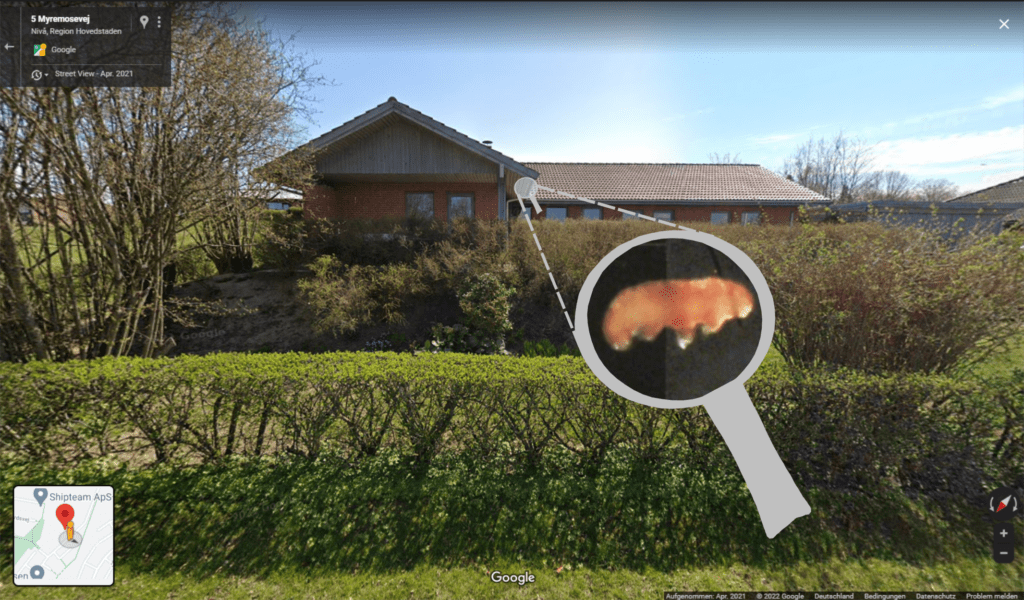
Tardigrades are something like the roly-polies of the animal world: unbreakable. When they are in a dangerous situation – be it extreme cold, radioactivity or drought – they literally play dead. In this state called “cryptobiosis”, the animal extremely reduces its metabolism and oxygen consumption. And it is precisely this characteristic that the physicists need to carry out their experiment.
Cold qubits
For their experiment, the research team did not use a box or a poison bottle. Instead, they entangled the tardigrade with a qubit (it is 2022 after all – qubits are in, radioactivity is out). More precisely, they used a superconducting qubit, such as Google and IBM use in their quantum computers.
A superconducting qubit is a tiny circuit that behaves like an artificial atom at low temperatures. Part of this circuit is a capacitor. In the simplest case, this consists of two opposing, electrically conductive plates that can store charge (marked in the circuit diagram below by the parallel lines; and yes, the pictures including the brown blob are actually from the preprint). Capacitors are found in almost all electrical components and also in superconducting qubits.
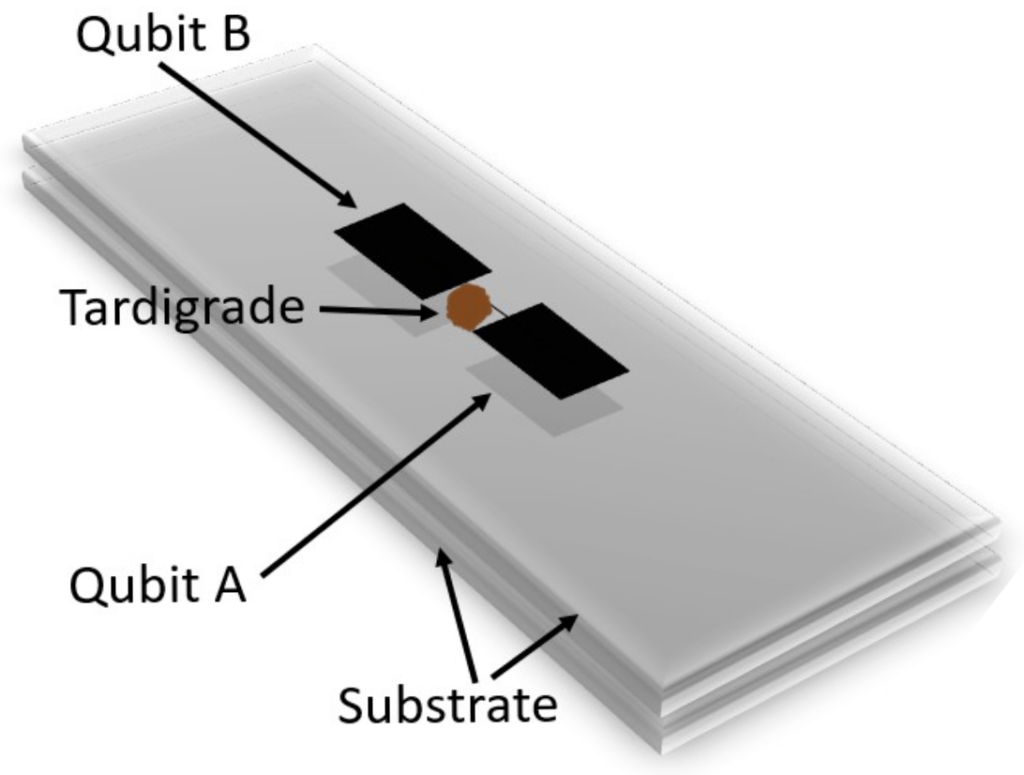
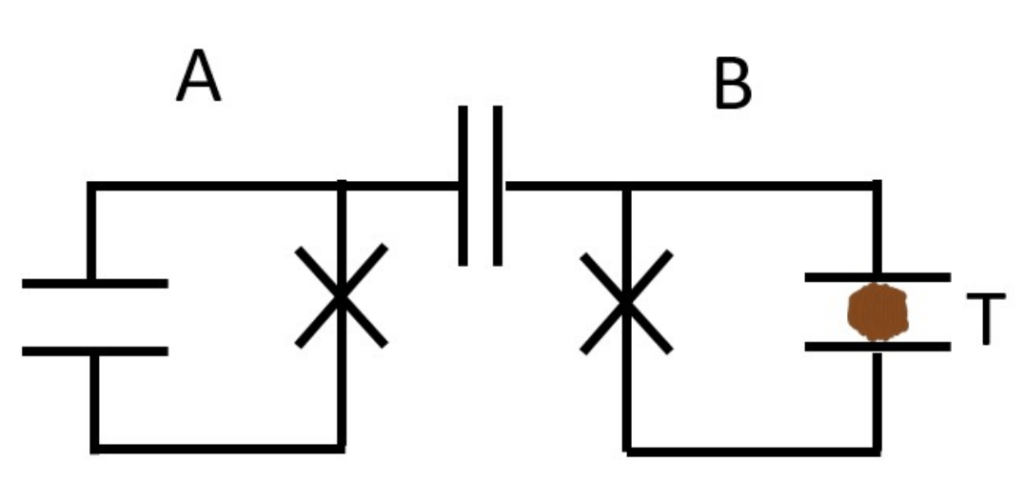
The crucial point why superconducting qubits and tardigrades have come together is the small detail that the circuits only behave quantum mechanically at very low temperatures. No problem for the tardigrades, which survived thirty years in Arctic ice! In fact, very low temperatures are almost always necessary to observe quantum effects, because even heat is enough to break the sensitive quantum effects. So to make “Schrödinger’s cat” a reality, we have to put it in a (very good) refrigerator!
The experiment
Undead tardigrades?
Let’s finally get down to the nitty-gritty: the entanglement between the tardigrade and the qubit. What exactly did the researchers do? I have to disappoint you: it was far less dramatic than you might think. Schrödinger’s cat is dead and alive at the same time – it is in a macroscopic superposition, i.e. in a superposition of two “visible” states. The tardigrade… well, you will see.
To entangle the tardigrade with the qubit, the researchers placed it inside the capacitor (as shown in the picture above). Was this intentional or did the Bachelor student simply leave the window open and a tardigrade crawled into the experiment? We will never know.
With the tardigrade inside, the properties of the capacitor, and more precisely its capacity, changes. The capacity indicates how much charge can be stored on the plates at a certain voltage. If you fill the space between the plates with a material – such as ceramic, plastic or a tardigrade – its capacity increases. How much is determined by the so-called relative permittivity. Air has a relative permittivity of 1 (so it doesn’t do anything), PET has 3.3, ceramics something between 20 and 14000 and tardigrades (as the researchers found out) 4. About as much as dry earth. Remember that for the next pub quiz.
Why am I telling you this? Because this is the entanglement the researchers found! Sounds unimpressive? I agree with you. You could put it this way: if I could stick my finger in the capacitor, it would have about the same effect. Is my finger therefore entangled with the qubit? Probably not. As one researcher put it, the qubit is just big enough for a tardigrade to rest in.

The harmonic tardigrade
To be fair, that was not quite the end of the story. The researchers have supported their hypothesis with a theoretical model. This is a common approach: I create a model of my system, calculate something with it and ideally this prediction agrees with the experiment.
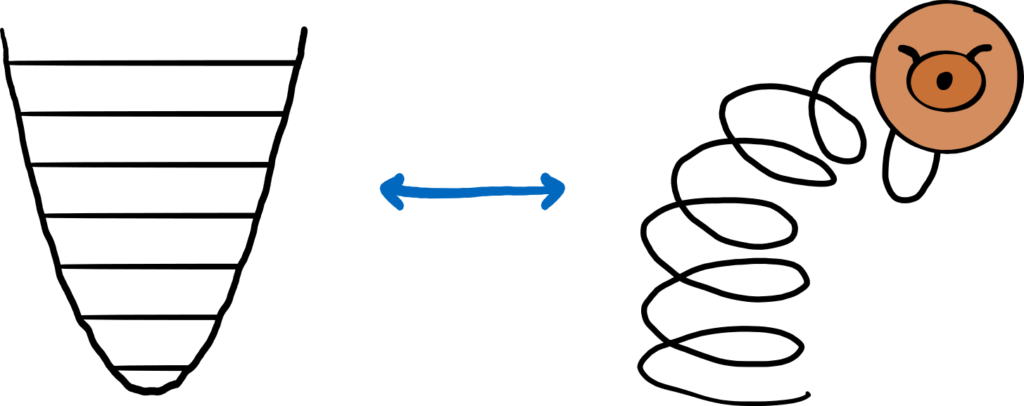
What I found terrific, however, is how they modelled the tardigrade. Because from a physical point of view, a tardigrade is far too complex. If you ask me, any system with more than one atom is far too complex. The research team apparently thought so too, because they described the tardigrade as a series of harmonic oscillators – the quantum mechanical equivalent of a spring. Next to the qubit (i.e. a system that can only assume two states), the harmonic oscillator is the simplest system there is in quantum physics. Let me clarify that. Do you know this joke?
A farmer has the problem that his cows are not giving enough milk. He calls in a physicist to help. After a few hours he says enthusiastically: “I have a solution, but it only applies to spherical cows in vacuum.”
The joke alludes to the fact that physicists sometimes simplify their problems to such an extreme that they no longer have much to do with reality. The harmonic oscillator is the spherical cow of quantum physics.
As soon as the tardigrade is a harmonic oscillator, the problem is easy to solve. And lo and behold: if I describe the tardigrade as a quantum mechanical system, then I can also entangle it quantum mechanically with the qubit. How surprising!
The tardigrade as qubit
After the researcher had successfully described the entanglement between the tardigrade and the qubit theoretically(!), they realised: hm, actually only two states of the oscillator-tardigrade are relevant for the experiment. Two states? That’s even better! That’s a qubit! Oh yes: they describe the tardigrade – a multicellular living being – as a qubit! A system with only two possible states!
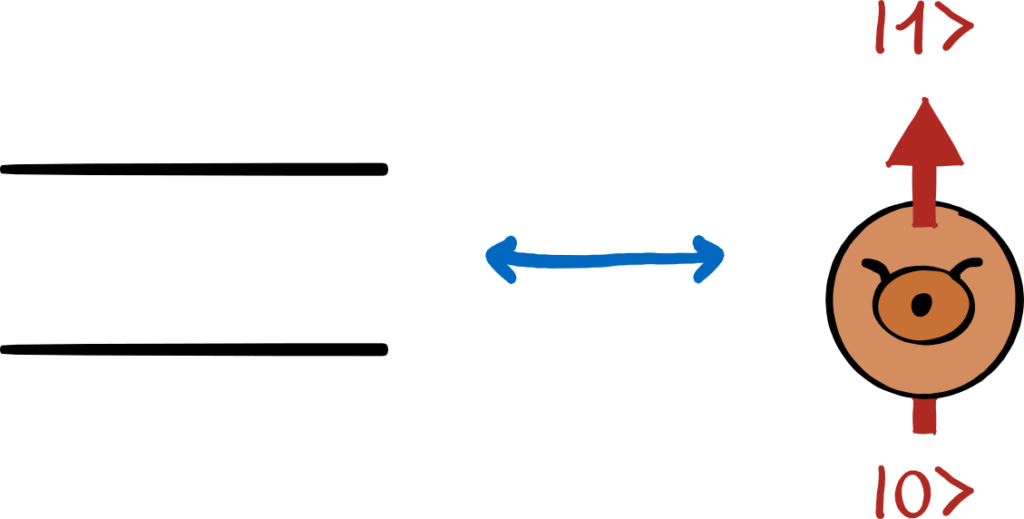
The proof?
However, the preprint is not just about a theoretical model but it also presents a real experiment. So the researchers had to somehow prove that what they claim actually happens in the experiment: that the tardigrade is entangled with the qubit.
They tried this in a roundabout way. First they entangled the first qubit (allegedly) with the tardigrade. Then they entangled this tardigrade qubit with a second qubit. They then measured the entanglement of the two qubits experimentally. Because the result agrees with the predictions of the theoretical model, the researchers conclude: the tardigrade must have been entangled with the first qubit.
However that is not a clean conclusion. If one considers the tardigrade as a normal, non-quantum mechanical stuffing material of the capacitor, the outcome of the experiment would be the same. This does not necessarily mean that the tardigrade and the qubit were not entangled. But it does mean that the experimental results do not prove entanglement. In fact, the experiment as described in the preprint does not even prove that the tardigrade influenced the qubit in any way.
What now?
I was asked whether this article will have negative consequences for the researchers. Whether they have lost their reputation, their credibility, even their job.
No, the whole thing probably has absolutely no consequences. As I said at the beginning, this is a preprint. A draft for an article that has been uploaded to a public platform. Anyone can upload what he or she wants. Besides, the results are not deliberately wrong or even an attempt at fraud. They just don’t show what the researchers claim. This kind of thing happens all the time. If the article hadn’t gone viral, it would have gone unnoticed just like thousands of other articles that are posted on the internet every day.
What is undoubtedly impressive, however, is the tardigrade’s performance. A piece of dust would have had a similar effect in the experiment as the frozen tardigrade (we remember: the experiment was conducted at -273°C). However, it would not have had the same outcome if a lively, crawling, warm tardigrade had been sitting inside. Quantum effects are very sensitive. If anything had moved, the entanglement between the two qubits would have been destroyed. This means: the tardigrade was without any signs of life during the experiment – and happily crawled its way afterwards.
A little animal that can do this might one day really “become” Schrödinger’s cat and conquer the quantum world. Slowly, one paw at a time.
Do you like what you read? Then you can buy me a coffee here! And if you don’t want to miss any new posts, don’t forget to subscribe to my blog.

